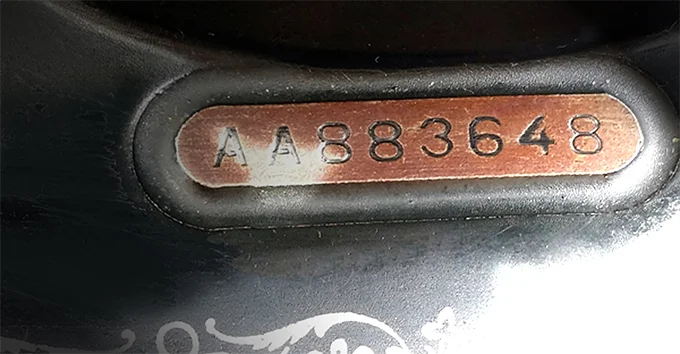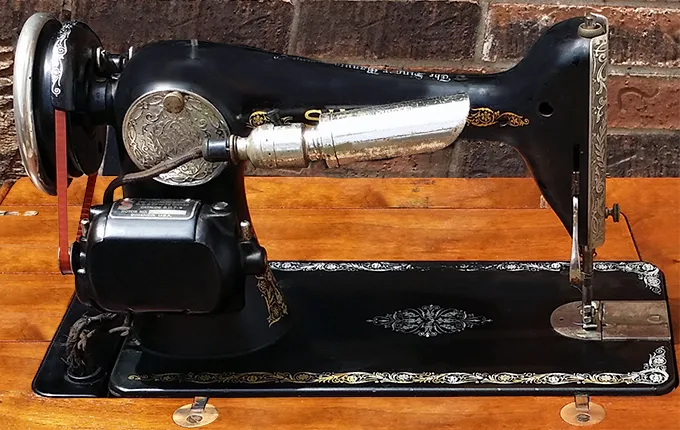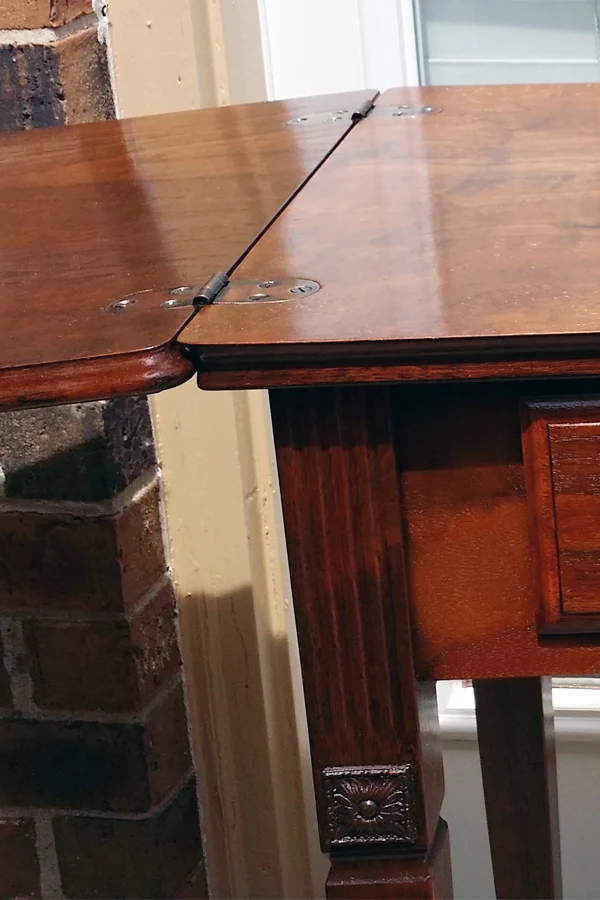This vintage Singer sewing machine will not only be a beautiful addition to your collection, it's ready to use! The motor works great and it has a working knee controller that turns up and out of sight when the sewing machine cabinet is closed —making it a workhorse of a sewing machine that can double as a laptop desk, library or serving table.
I acquired this sewing machine and cabinet at an estate sale where the family told me it had been passed down through five generations. Judging by its condition, you can tell it was a well cared for family heirloom.
Based on the serial number, AA883648, this machine is a Singer Class 66 sewing machine manufactured in 1926 at Singer's Elizabethport Factory in Elizabethtown, New Jersey. Around 80,000 Class 66 sewing machines were manufactured by Singer that year and many, like this one, are still in operation today.

If your Singer doesn't have a visible serial number, try the Sandman's "Collectible Singer Sewing Machine Identification Template."]
This Singer Class 66 Sewing Machine was Built to Last
Despite having superior technology, you won't see a modern sewing machine in good working order after 96 years! But with the right care and maintenance, vintage sewing machines like this Singer Class 66 can practically run forever.The reason for this is simple. Vintage sewing machines don't have any plastic parts.
With the exception of the belt, which is made of rubber, almost every part of a Singer Class 66 is made of metal. Metal parts are extremely hard to break, so they rarely need replaced. And when you eliminate all of the wires, electronic components and corruptible software, you're left with a beautifully basic sewing machine that was built like a classic car — heavy, strong and with care.
The Vintage Class 66 is Basic, But Beautiful
When I say the Class 66 is basic, I don't mean to imply that it's plain Jane. On the contrary, the vintage Singer Class 66 is a beautiful historic piece. It's not the sort of sewing machine that you tuck away when company calls. The gold filigree decals on this model are understated and elegant, although I admit not as sought-after as the exotic Singer Class 66 Red Eye decals valued by Singer sewing machine collectors.Still, the Class 66 is among the more popular collectible Singer Sewing Machines, along with Singer's Featherweights, the Singer 302, the Singer 301, the Singer class 127 and Singer's violin shaped machines.
Noted sewing machine expert, author Alex Askaroff (sewalot.com,) says the Singer Class 66 was "the first mass produced sewing machine, in my opinion, that produced a near perfect stitch. When sewing well the 66 will out-sew nearly any modern machine through a huge variety of fabrics from linen to lace, horse blankets to buckram. It is simply near perfect engineering..."
But the leap in engineering came at a high cost. The Singer Class 66 was one of the most expensive sewing machines of it's day — costing several months wages.
Even so, its simplicity of threading, high arm clearance and perfection of stitch made the Class 66 an instant best seller.
Askaroff tells a story about a woman in England who loved her Class 66 so much she literally risked life and limb for it!
Instead of running for shelter when the Germans bombed her hometown during WII, Annie Pratt ran home to save her beloved Singer Class 66 sewing machine. Somehow she managed to pull the heavy machine from the flames and escape with only a few burns on her hands.
The Singer Class 66 is a full-sized sewing machine that weighs around 30 lbs, so they were usually sold in treadle tables or cabinets.
This sewing machine cabinet, which is in beautiful condition, appears to be the "Singer De Luxe Library Table No. 40." The wood is Walnut. As far as I can tell the cabinet was manufactured sometime between 1926 and 1933 and still has the original finish.
The DeLuxe Library Table No. 40 cabinet was made for Singer Class 66 and 101 sewing machines. It has two table leaves that open from the center of the cabinet and fold out to create a spacious work surface.
The center drawer of the No. 40 cabinet has three compartments for attachments and sewing supplies.
The sewing machine is spring-mounted below. You just reach into the cabinet and pull it up; then it locks into place.
I found a wonderful vintage Singer advertisement from the 1920s (see pic) describing the No. 40 cabinet and Class 66 sewing machine as,
"...the famous Singer No. 66 round bobbin machine, equipped with Singer Motor and Singerlight, and enclosed in De Luxe Library Table No. 40 shown and described on Page 13. This new combination of time-tested and justly popular Singer units will especially appeal to the many thousands of women who have used the Singer 66 as a treadle machine and prefer it to all others."
I'm Asking $125 cash for the sewing machine and No. 40 cabinet together. Please feel free to contact me with any questions.
— Happy Sewing!
FREE DOWNLOADS
Singer Class 66 Sewing Machine Instruction Manuals
.
- Singer 82387 No. 66 Singer Sewing Machine - Oscillating Hook for Family Use (Instruction Manual| 29 pgs.)
- Instructions for Timing and Adjusting Singer Sewing Machine 66 (Photocopy of vintage manual | 11 pages)
- 1929 Singer Class 66 Sewing Machine Instruction Manual (http://ismacs.net | 33 pages)
Additional Information and How-To’s
- How to thread a Singer 66 Sewing Machine [video]
- How to thread a Singer Treadle sewing machine. [Video]
- Singer Model 66 Demonstration 58 minutes [video]
- How to wind a bobbin on a Singer Treadle sewing machine. [Video]
- How to load the bobbin on a Singer Treadle sewing machine. [Video]
- Buy vintage Singer 66 restoration decals - singer66decals.com
- Where to oil a Singer 66 - oldsingersewingmachineblog.com


























